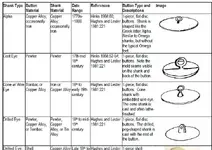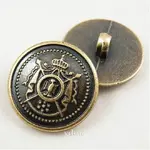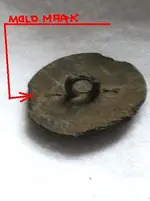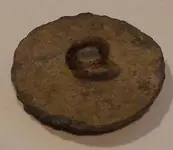You are using an out of date browser. It may not display this or other websites correctly.
You should upgrade or use an alternative browser.
You should upgrade or use an alternative browser.
can anyone help identify this button something good or trash
- Thread starter jtw1313
- Start date
Bigcypresshunter
Sapphire Member
- Joined
- Dec 15, 2004
- Messages
- 27,000
- Reaction score
- 3,340
- Golden Thread
- 0
- Location
- South Florida
- Detector(s) used
- 70's Whites TM Amphibian, HH Pulse, Ace 250
- Primary Interest:
- Beach & Shallow Water Hunting
I PMed CBG to help us date this button.
Amazon Forum Fav 👍
Upvote
0
HutSiteDigger
Silver Member
- Joined
- Nov 26, 2012
- Messages
- 2,849
- Reaction score
- 1,283
- Golden Thread
- 0
- Location
- Stafford,Virginia
- Detector(s) used
- Fisher 1266x and a shovel
- Primary Interest:
- All Treasure Hunting
I think your right in the way of looking @ the back of the button and going by the shank details on this exact button to determine that it is early 19th century, but sometimes this can play tricks on you if like in the case of this button the face of the button is so worn and corroded you have to judge the age from the back of the button.. Really the only way imo too 100% ID the button is from what is on the front, because lot of buttons were still produced or made with this style shank for different reasons so a button that looks say 1820ish still could have been made alot later then 1820. Be real nice if we could 100% ID everything but we try!
No backmarks really do suck when trying to ID something.
No backmarks really do suck when trying to ID something.
Upvote
0
Bigcypresshunter
Sapphire Member
- Joined
- Dec 15, 2004
- Messages
- 27,000
- Reaction score
- 3,340
- Golden Thread
- 0
- Location
- South Florida
- Detector(s) used
- 70's Whites TM Amphibian, HH Pulse, Ace 250
- Primary Interest:
- Beach & Shallow Water Hunting
Here is a good link on dating buttons by type. This appears to be a cast eye type and they have it listed as old. http://www.daacs.org/wp-content/uploads/buttons.pdf
I guess its certainly possible to be a modern pot metal button made to look old with a shiny gold nickel plating...
I guess its certainly possible to be a modern pot metal button made to look old with a shiny gold nickel plating...
Attachments
Last edited:
Upvote
0
HutSiteDigger
Silver Member
- Joined
- Nov 26, 2012
- Messages
- 2,849
- Reaction score
- 1,283
- Golden Thread
- 0
- Location
- Stafford,Virginia
- Detector(s) used
- Fisher 1266x and a shovel
- Primary Interest:
- All Treasure Hunting
Upvote
0
TheCannonballGuy
Gold Member
- Joined
- Feb 24, 2006
- Messages
- 6,607
- Reaction score
- 13,455
- Golden Thread
- 0
- Location
- Occupied CSA (Richmond VA)
- Detector(s) used
- White's 6000, Nautilus DMC-1, Minelab
- Primary Interest:
- Relic Hunting
BigCypressHunter wrote:
> I PMed CBG to help us date this button.
There has to be a reason why none of the "old-time button" experts mentioned by BCH have posted in this discussion. I of course cannot speak for the others, only for myself. I've gotten very frustrated with posters who come to the What-Is-It forum wanting relic ID help but do not bother to read PBK's up-top post titled "Please read before posting items in What-Is-It." The poster of the (apparently) Belgian-shield button doesn't tell us what country it was found in, nor what part of the country. (Also, his Profile does not tell us where he is located.) He has never bothered to give us a size-measurement of the button. The situation is made even worse when the help-requester won't answer important questions about the button. Quite a few posts back in this discussion, BigCypressHunter asked him several questions: "Is the loop the same metal as the button? Test with a magnet. Does it look as if the loop was soldered on or is it cast all in one piece?"
The finder of the button has posted since then, but hasn't bothered to answer those important questions for accurately identifying it and time-dating it.
So, the only answer I can give him is based on LACK of important information, due to his un-cooperativeness. Based on what can be seen in the photos, it appears to be not from the 1700s or 1800s -- it appears to be a worthless "Fashion" civilian-clothing button from the modern era, made of solid-cast cheap grey potmetal which had an equally cheap thin "gold-tone" finish. That is my analysis of his button until he decides to cooperate with this forum's rules ("Please read before posting"), AND he gets around to providing answers to BigCypressHunter's very important questions about the button. Also, the name of the country (and what part of the country) it was dug in. Knowing whether it was dug in the US, Britain, Belgium, Canada, Australia -- or someplace else -- IS important for accurately identifying it.
> I PMed CBG to help us date this button.
There has to be a reason why none of the "old-time button" experts mentioned by BCH have posted in this discussion. I of course cannot speak for the others, only for myself. I've gotten very frustrated with posters who come to the What-Is-It forum wanting relic ID help but do not bother to read PBK's up-top post titled "Please read before posting items in What-Is-It." The poster of the (apparently) Belgian-shield button doesn't tell us what country it was found in, nor what part of the country. (Also, his Profile does not tell us where he is located.) He has never bothered to give us a size-measurement of the button. The situation is made even worse when the help-requester won't answer important questions about the button. Quite a few posts back in this discussion, BigCypressHunter asked him several questions: "Is the loop the same metal as the button? Test with a magnet. Does it look as if the loop was soldered on or is it cast all in one piece?"
The finder of the button has posted since then, but hasn't bothered to answer those important questions for accurately identifying it and time-dating it.
So, the only answer I can give him is based on LACK of important information, due to his un-cooperativeness. Based on what can be seen in the photos, it appears to be not from the 1700s or 1800s -- it appears to be a worthless "Fashion" civilian-clothing button from the modern era, made of solid-cast cheap grey potmetal which had an equally cheap thin "gold-tone" finish. That is my analysis of his button until he decides to cooperate with this forum's rules ("Please read before posting"), AND he gets around to providing answers to BigCypressHunter's very important questions about the button. Also, the name of the country (and what part of the country) it was dug in. Knowing whether it was dug in the US, Britain, Belgium, Canada, Australia -- or someplace else -- IS important for accurately identifying it.
Last edited:
Upvote
0
HutSiteDigger
Silver Member
- Joined
- Nov 26, 2012
- Messages
- 2,849
- Reaction score
- 1,283
- Golden Thread
- 0
- Location
- Stafford,Virginia
- Detector(s) used
- Fisher 1266x and a shovel
- Primary Interest:
- All Treasure Hunting
I agree with yah 100% CannonBall ! I was going too see if this poster would at least post a location of where this button is found, i'm assuming they think we all live in the same area or even on the same street as them in this so called "little world" of ours.. 

Upvote
0
Bigcypresshunter
Sapphire Member
- Joined
- Dec 15, 2004
- Messages
- 27,000
- Reaction score
- 3,340
- Golden Thread
- 0
- Location
- South Florida
- Detector(s) used
- 70's Whites TM Amphibian, HH Pulse, Ace 250
- Primary Interest:
- Beach & Shallow Water Hunting
He was following the post in the beginning for the first few days very well.
Thanks CBG for your time.
Im thinking what Bryan says about the horizintal lines. That may signify modern.
Thanks CBG for your time.
Im thinking what Bryan says about the horizintal lines. That may signify modern.
Last edited:
Upvote
0
Silver Searcher
Gold Member
How many times do we see this  people posting stuff with out giving details, it's not just over there, but some of the posters from this side as well
people posting stuff with out giving details, it's not just over there, but some of the posters from this side as well 
SS
 people posting stuff with out giving details, it's not just over there, but some of the posters from this side as well
people posting stuff with out giving details, it's not just over there, but some of the posters from this side as well 
SS
Upvote
0
Bryanhashemi
Hero Member
- Joined
- Mar 15, 2012
- Messages
- 548
- Reaction score
- 108
- Golden Thread
- 0
- Location
- Savannah, Ga
- Detector(s) used
- Minelab E-trac, whites xlt
- Primary Interest:
- Relic Hunting
Yeah...pretty sure its a more modern button. Ive dug up alot of old buttons and early 20th century ones too. Im pretty confident its 20th century. im not a button expert but i know a little. It looks like it could be a blazer button (scottish style). Just a thought.
Upvote
0
Bigcypresshunter
Sapphire Member
- Joined
- Dec 15, 2004
- Messages
- 27,000
- Reaction score
- 3,340
- Golden Thread
- 0
- Location
- South Florida
- Detector(s) used
- 70's Whites TM Amphibian, HH Pulse, Ace 250
- Primary Interest:
- Beach & Shallow Water Hunting
I didnt mean to get anybody upset. I thought it would be an easy ID as to the dateline. I guess we need nore pics and/or information.
The Belgian Crest was used on many modern fashion buttrons there is no doubt but its the cast eye that makes me think there is a possibility of being old. How many cast eye buttons do you see from the 20th century?
The Belgian Crest was used on many modern fashion buttrons there is no doubt but its the cast eye that makes me think there is a possibility of being old. How many cast eye buttons do you see from the 20th century?
Upvote
0
TheCannonballGuy
Gold Member
- Joined
- Feb 24, 2006
- Messages
- 6,607
- Reaction score
- 13,455
- Golden Thread
- 0
- Location
- Occupied CSA (Richmond VA)
- Detector(s) used
- White's 6000, Nautilus DMC-1, Minelab
- Primary Interest:
- Relic Hunting
Just trying to be helpful to you here, BCH. A genuine "old" (1700s/1800s) cast eye button, especially a pewter one, should have a moldseam visible on its back ...as shown in the diagram chart you posted. But there is no moldseam visible on the back of the poster's button, even at extreme magnification.
Upvote
0
Bigcypresshunter
Sapphire Member
- Joined
- Dec 15, 2004
- Messages
- 27,000
- Reaction score
- 3,340
- Golden Thread
- 0
- Location
- South Florida
- Detector(s) used
- 70's Whites TM Amphibian, HH Pulse, Ace 250
- Primary Interest:
- Beach & Shallow Water Hunting
Yes I noticed the lack of a mould seam but I didnt know if it was always visible. . Thanks.
Upvote
0
Bigcypresshunter
Sapphire Member
- Joined
- Dec 15, 2004
- Messages
- 27,000
- Reaction score
- 3,340
- Golden Thread
- 0
- Location
- South Florida
- Detector(s) used
- 70's Whites TM Amphibian, HH Pulse, Ace 250
- Primary Interest:
- Beach & Shallow Water Hunting
Digging through my files, I found an authentic cast eye pewter button pic with the mould seam SBG mentioned to compare. Without further information this ones solved as a 20th century pot metal fashion button.
Attachments
Last edited:
Upvote
0
Similar threads
- Replies
- 1
- Views
- 137
- Replies
- 2
- Views
- 249
- Replies
- 7
- Views
- 298
Users who are viewing this thread
Total: 1 (members: 0, guests: 1)








